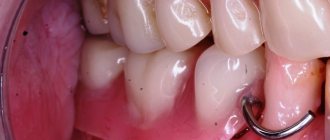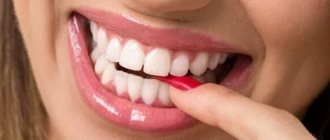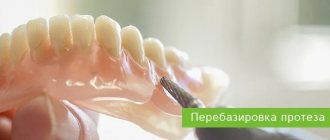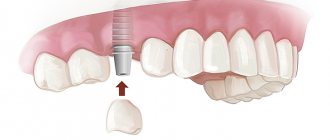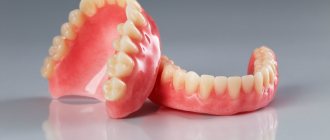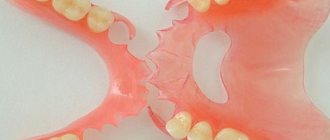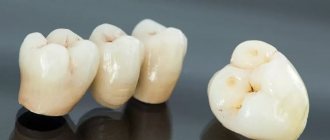- Linear fracture
- Loss of an artificial tooth from a prosthesis
- Fracture of clasp (metal hook)
- Relining the prosthesis
Removable plastic dentures tend to break. This happens due to their careless use by patients or due to a banal accident (slipping out of their hands, for example). Breakdowns of dentures are divided into 3 groups, each repair is carried out by a dental technician.
- linear fracture: splitting of a plastic prosthesis into two parts;
- loss of an artificial tooth from a prosthesis or removal of the patient’s own tooth;
- fracture of the clasp (metal hook) in the prosthesis.
What is a removable plate prosthesis?
A removable plate prosthesis is a base made of polymer materials into which artificial teeth are inlaid. This design is used in the absence of several or all jaw teeth, and due to the low cost and ease of manufacture, removable plastic laminar dentures are very popular among patients.
Indications
The indications for the use of removable plate dentures for teeth are very wide, since there are much fewer restrictions for this type of system than for implantation or classical dental prosthetics. In particular, these are:
- complete or partial edentia;
- impossibility of implantation or classical prosthetics (for clinical or financial reasons);
- the need to wear temporary structures before installing permanent dentures;
- allergy to metal.
Contraindications
- severe periodontal diseases;
- problems of the circulatory system;
- undergoing a course of radiation or chemotherapy;
- mental illness.
The materials for making plate dentures are usually plastic, acrylic, nylon or polyurethane. Often, it is the composition that largely influences the final cost of the design: modern plate dentures are made of hypoallergenic acrylic or nylon, which ensures comfortable wearing and almost completely eliminates allergic reactions. Based on appearance and functionality, these prostheses are divided into two types: partial laminar dentures and complete laminar dentures. Let's look at these systems in more detail.
Features of repair depending on materials
The different materials from which the devices are made dictate their own characteristics of their restoration and the selection of special and compatible replenishing agents. Thus, repair of the base of acrylic dentures, which are fragile, is carried out with self-hardening resins.
Repair of nylon devices consists mainly of restoring crowns, which may have chips or cracks - the elastic base itself is rarely damaged. But it stretches after just a couple of years of wearing it - nothing can be done about it, you will have to completely change the prosthesis. Crown defects are eliminated using adhesives and resins. All types of breakdowns occur with short-lived plastic products.
Metal-ceramic structures are less susceptible to damage and are generally more reliable than others, but chipping of the ceramic coating is also possible here. It is restored, as a rule, with composite materials, applied in several layers over the chip.
Today, dentists use many different modern materials, glues, adhesives, both imported and domestic, which allow reconstruction to be carried out quite quickly. Dental technicians and orthopedists also have advanced equipment, computer programs and tools at their disposal.
Partial plate denture
A partial removable plate denture replaces one or more lost teeth, so its shape and size directly depend on their number. To install such a prosthesis, you do not need to grind down the adjacent teeth: fixation of partial removable laminar dentures is carried out in several ways.
Types of fixation of removable laminar dentures:
Metal clasps
Hook-shaped processes starting at the base of the prosthesis and clasping the neck of the supporting tooth. Currently, they are rarely used, as they can damage tooth enamel.
Metal-free clasps
A more modern variation of conventional clasps. Made from soft, metal-free materials.
Attachmen
Small clasps that are installed on the prosthesis itself and the supporting teeth. When installing the structure, these parts are securely fixed.
What kind of structural failures do patients encounter?
The most common breakdowns that dentists deal with involve loss of structural integrity—crowns or fasteners “fall off.” Different types of products have their own typical damage.
Possible damage to dental crowns:
- chipping, when a piece of material breaks off from a solid system. Crowns are often subject to such damage during chewing. Then their uneven and rough edges injure soft tissues. In the case of combined crowns, it happens that small fragments of the outer ceramic or plastic coating break off,
- cracks in the enamel of an artificial tooth: both thread-like shallow cracks and quite noticeable cracks can form on the surface,
- change in the color of artificial teeth over time due to coloring products: uneven deposition of pigments on the surface and the inability to clean them with conventional pastes and differences from the natural color of your own teeth require contacting a dentist,
When choosing crowns, you must initially understand the possibility of future repairs, as well as the likely service life of the products. For example:
- dental crowns made of metal-plastic or solid plastic will last no more than 3-5 years, and after just a few months you may encounter a number of unpleasant problems: a piece of plastic often breaks off from the metal base, the material itself changes color under the influence of external dyes (but this is mainly, if the crown is placed for several weeks or months - in this case, in order to reduce the cost, it is simply not worked out efficiently),
- chips and cracks very often form on dental crowns made of solid ceramics, since the material is not strong enough and does not always withstand heavy loads,
- dental crowns made of metal-ceramics are quite strong, and the only thing the patient may encounter is the chipping of the ceramic from the metal base,
- Dental crowns made of zirconium dioxide are actually an eternal option; they are not repaired, since their service life is more than 15-20 years. In general, reconstruction of the products is not required - they are durable and the most reliable.
Possible failures of bridges:
- cracks and chips of the surface of dental crowns as part of such a prosthesis,
- change in the color of the enamel of artificial teeth,
- loss of individual artificial teeth from the base of the structure,
- breakage of fasteners: clasps, locks or “wings” of adhesive systems are thin and small elements. Natural wear and improper load distribution increase the likelihood of failure,
- damage to a living supporting tooth: damage to ground teeth hidden under the crowns of bridges by caries or pulpitis is not uncommon. Since the teeth are pulpless, it is not always possible to notice the onset of a pathological prosthesis in time (especially if you skip preventive examinations with a doctor). In this case, the bridges become mobile and fall out along with the teeth on which they are attached.
South Korean implant Osstem - 20,000 rub.
Hurry up to sign up for a free consultation and lock in promotional prices.
Call now or request a call
Opening hours: 24 hours a day - seven days a week
Possible breakdowns of removable dentures:
- formation of scratches and cracks: abrasive toothpastes, too hard products, improper use of teeth, sudden temperature changes can damage the surface of the product (especially plastic crowns and acrylic bases),
- damage to dental crowns: discoloration of enamel, cracks and chips, or even complete loss from the base,
- damage to fasteners,
- fractures in different directions: the device can completely split into two or more parts. As a rule, a fracture of a denture passes along the line of cracks, if they were not eliminated in time - where it is thin, it breaks,
- the appearance of a loose fit due to gaps between the base and gums, between the base and living teeth, displacement and inconsistent fastening of the structure. A relocation is needed here. What it is? This is a series of manipulations to adjust the base to improve its fixation properties, and the dentist’s actions to ensure the correct pressure of the device on the gums.
All these malfunctions require contacting a dentist. If, when the system breaks, its further use is impossible, then other flaws, such as scratches, cracks and chips, it seems, can wait. But there is no need to delay troubleshooting, since many violations, if not corrected, lead to more serious consequences. For example, in the resulting chips, scratches and cracks, a large number of bacteria accumulate, which lead to inflammation of the gums under dentures and living teeth.
Complete removable plate denture
Removable laminar dentures in the case of complete absence of teeth simulate the patient’s upper or lower jaw, so that they are significantly larger in size than removable laminar dentures in the case of partial absence of teeth. As a rule, such a design has a rather voluminous base (especially a plate prosthesis for the upper jaw), which is necessary in order to achieve a tight fit and ensure more or less stable fixation.
Methods of fixation of complete removable laminar dentures:
Clasps or attachments
Such fixation methods are used if at least a pair of healthy teeth remain on any of the jaws.
Suckers
Additional fixation elements that are usually used when a complete removable plate denture is installed on the upper jaw.
Fixation on implants
Installation of a prosthesis supported by implants. This is the most reliable, expensive and durable method of prosthetics, which is not always possible due to contraindications to implantation and the high cost of the technique.
Manufacturing of plate dentures
The technology for manufacturing a plate prosthesis is considered simpler compared to the creation of most fixed structures (crowns or bridges), so the patient receives a ready-made system quite quickly (unless we are talking about installing implants).
Manufacturing stages:
- Initial consultation, examination, creation of panoramic images of the jaw and approval of the design of the prosthesis.
- Taking impressions and making a model of the patient's jaw. Determination of bite parameters.
- Making and fitting of a wax structure.
- The final stage of manufacturing a plate prosthesis, polishing the finished structure and eliminating cosmetic defects.
- Fitting and installation of the finished structure.
Is it possible to carry out repairs yourself at home?
If we talk about eliminating damage to dental devices at home, it is obvious that high-quality professional materials and equipment are not available for self-repair. However, there are times when there is a need for urgent repairs to the structure. Cracks, beginning fractures, crowns falling out or a final split into a couple of parts cannot be repaired yourself - this is a health risk! If you are far from home or cannot see your orthopedist, you can come to any dentistry. Good doctors and clinics always meet their patients halfway and will definitely come to the rescue if restoration needs to be done urgently.
Do-it-yourself repairs can completely damage the device and then it will be impossible to repair it in a professional laboratory or workshop. In addition, self-repair will void your device warranty.
To temporarily secure the structure from which the hook has broken off, you can use a special dental glue for fixing dentures, that is, simply temporarily “plant” the structure in the mouth not on the hooks, but on the glue. And go to the clinic as soon as possible.
What you should never do is use industrial and construction adhesives to connect parts of the prosthesis - they are not intended for this. Contact of toxic components with mucous membranes can cause serious allergies and poisoning. Also, these compounds may be completely incompatible with the materials of the device and will simply ruin it.
Self-repair can irreparably change the shape of the product, disrupt all the relationships taken into account by the orthopedist, and then you will simply have to throw it away, since further use of such a design will be inconvenient, painful, and dangerous.
Advantages and disadvantages
Prosthetics with plate prostheses have a number of advantages and disadvantages, which may vary depending on the type of structure. Before agreeing to have dentures installed, find out all the strengths and weaknesses of your new teeth. In addition, your attending physician should tell you about the types of plate prostheses and help you choose the best option.
- fragility (under heavy loads, a fracture of the plate prosthesis often occurs);
- short service life (up to 5 years);
- certain discomfort when wearing and difficulty getting used to (this applies to a greater extent to outdated designs);
- no load on bone tissue (except for installation supported by implants).
- ease of manufacture;
- low price. Prosthetics with removable plate dentures are considered one of the most cost-effective options for dental restoration in orthopedics;
- restoration of chewing function of teeth;
- acceptable appearance.
Repairing a plate denture for teeth
Constructions of this type are considered quite fragile, especially at the point where the soft supporting part is attached to the artificial teeth. Repairing removable plate dentures is not always possible, and the degree of its success depends on the nature of the damage. In case of minor chips or breakage of clasps and attachments, restoration of removable plate dentures is often carried out, but in case of serious damage, the design usually has to be completely changed. The main reasons for the breakdown of plate dentures usually lie in careless handling (which often leads to falls of the structure) and attempts to bite through hard objects with dentures (for example, nut shells).
Prices
| Service | Price |
| Removable acrylic (plate) dentures | from 15,200 rub. |
| Taking a two-layer impression | from 900 rub. |
| Taking an alginate impression | from 500 rub. |
| Restoration of a removable denture | from 3,500 rub. |
To avoid possible misunderstandings, please clarify the cost of services in clinics with the administrator or during a consultation with a doctor. Prices on the website are not a public offer.
Sign up for a consultation

